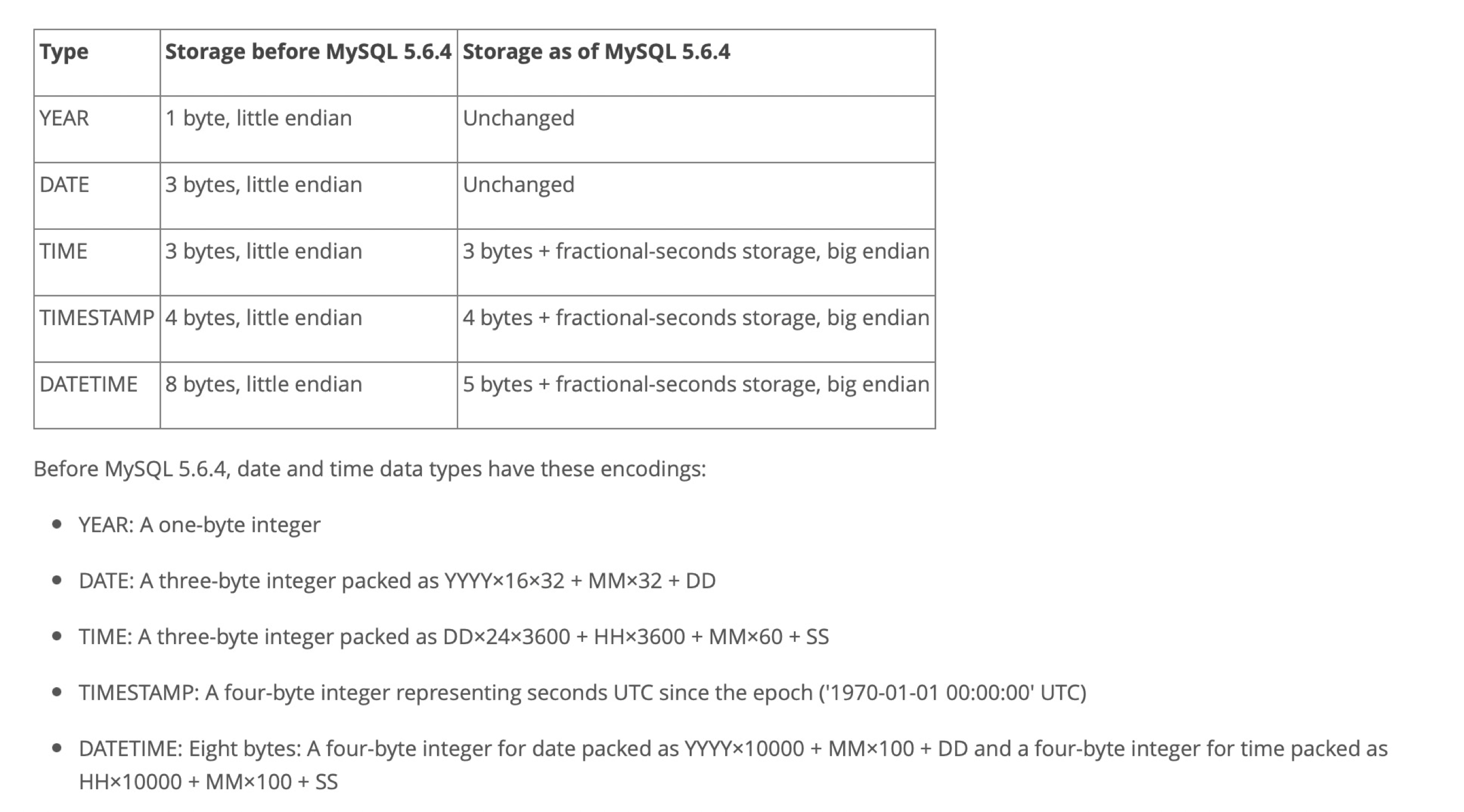MySQL Temporal Data Types
Author: lefeng
前言
日常工作中,我们会经常遇到日期和时间这类数据,MySQL有对应的数据类型来存储,分别是DATE,TIME,DATETIME,TIMESTAMP和YEAR,这些数据类型统称为temporal数据类型。
MySQL在文档 https://dev.mysql.com/doc/refman/8.0/en/date-and-time-types.html 中对日期和时间相关的数据类型做了介绍,本文将对这些内容进行梳理,并深入到MySQL内核层探究其实现。
概述
在5.6.4版本以后,MySQL对这些数据类型的支持有了部分变化,
- 把原来little-endian的存储方式变成了big-endian。这样一来,可以按照字节对数据进行比较(byte comparable),而不用等到读取所有字节后再进行比较,可以提升性能。
- 新增小数部分的支持(小数点后最多支持6位数字),以满足某些场景下用户对更高精度的需求。仅限于TIME/TIMESTAMP/DATETIME三种类型。

如果要定义一个带有小数部分的数据类型,可以使用type_name(fsp),fsp是0-6的数字,表示小数点后数字的位数。0表示无小数位,如果不指定,默认是0。小数点后每2位数字占用一个字节,最多占用3个字节(6位数字)。
下面是一个定义带小数部分的数据类型的例子,
CREATE TABLE t1 (t TIME(3), dt DATETIME(6), ts TIMESTAMP(0));
YEAR
年份,显示格式为4个字符表示的年份。范围是1901- 2155,可以为字符或者数字。
值得注意的是,输入的值也可以是2个字符或数字表示的年份,MySQL会在解析时自动做一个转换,
0 - 69 : 2000 - 2069
70 - 99 : 1970 - 1999
DATE
日期。显示格式是YYYY-MM-DD,范围是1000-01-01 to 9999-12-31。
TIME(fsp)
存储时间数据,显示格式为hh:mm:ss [.fraction]。可接受的值的范围是-838:59:59.000000 到 838:59:59.000000。
至于为什么有负时间值,MySQL文档给了说明,
The hours part may be so large because the
TIMEtype can be used not only to represent a time of day (which must be less than 24 hours), but also elapsed time or a time interval between two events (which may be much greater than 24 hours, or even negative).
可以看到,这里所指的时间不仅可以表示一天中的某个时间点,还可以表示两个事件的时间间隔,自然就可以超过24小时,且可能为负值。
DATETIME(fsp)
包含日期和时间两部分,显示格式是YYYY-MM-DD hh:mm:ss [.fraction],支持的日期范围是 1000-01-01 00:00:00.000000 到 9999-12-31 23:59:59.999999。
TIMESTAMP(tsp)
时间戳,包含日期和时间两部分,显示格式是YYYY-MM-DD hh:mm:ss [.fraction],支持的日期范围是1970-01-01 00:00:01.000000 UTC 到 2038-01-19 03:14:07.999999 UTC。
其表示的是自1970-01-01 00:00:00开始的时间差(秒),所以1970-01-01 00:00:00不是一个合法值,因为其对应的时间差是0,而0已经用来表示0000-00-00 00:00:00。当输入非法的日期或者时间值时,解析的时候会把其转换成0000-00-00 00:00:00。
内核层的实现
本部分将以MySQL 8.0.18的代码为基础,介绍MySQL从客户端接收到日期和时间数据后的处理流程,以及存入磁盘的过程。
在开始之前,我们先介绍两个数据结构,MYSQL_TIME和timeval。
/*
Structure which is used to represent datetime values inside MySQL.
We assume that values in this structure are normalized, i.e. year <= 9999,
month <= 12, day <= 31, hour <= 23, second <= 59. Many functions
in server such as my_system_gmt_sec() or make_time() family of functions
rely on this (actually now usage of make_*() family relies on a bit weaker
restriction). Also functions that produce MYSQL_TIME as result ensure this.
There is one exception to this rule though if this structure holds time
value (time_type == MYSQL_TIMESTAMP_TIME) days and hour member can hold
bigger values.
*/
typedef struct MYSQL_TIME {
unsigned int year, month, day, hour, minute, second;
unsigned long second_part; /**< microseconds */
bool neg;
enum enum_mysql_timestamp_type time_type;
} MYSQL_TIME;
对于temporal数据类型,MySQL在接收到客户端发送来的日期和时间数据后,会进行解析,将结果保存在MYSQL_TIME这个结构体中,其中,
-
second_part,小数部分表示的微秒(us),其值为 “小数部分 * 1000000”。如果小数为0.001,这里的值为1000。
-
neg,是否为负值,仅对TIME类型有效。
如果目标列是TIMESTAMP数据类型,会进一步将MYSQL_TIME中保存的值转换成相对于1970-01-01 00:00:00的时间差(函数datetime_with_no_zero_in_date_to_timeval()),并保存在timeval结构体中。
typedef struct timeval {
long tv_sec;
long tv_usec;
} timeval;
接下来,对于一些数据类型,如DATE,将解析后的日期和时间数据转换成整数,根据目标列自身的长度(固定长度),以big-endian的方式进行存储。
/**
Convert in-memory date representation to on-disk representation.
@param ltime The value to convert.
@param [out] ptr The pointer to store the value to.
*/
void my_date_to_binary(const MYSQL_TIME *ltime, uchar *ptr) {
long tmp = ltime->day + ltime->month * 32 + ltime->year * 16 * 32;
int3store(ptr, tmp);
}
而对于支持小数的部分数据类型,则会区别对待,
- TIMESTAMP,直接将
timeval中保存的秒和微秒以big-endian的方式存储到磁盘中。 - TIME和DATETIME,将小数部分的值保存在longlong值低3位字节中,整数部分的值保存在其它高位字节中,这种方式称为“紧凑格式”(packed format)。
TIME类型的值转换成紧凑格式,
/**
Convert time value to numeric packed representation.
@param my_time The value to convert.
@return Numeric packed representation.
*/
longlong TIME_to_longlong_time_packed(const MYSQL_TIME &my_time) {
/* If month is 0, we mix day with hours: "1 00:10:10" -> "24:00:10" */
long hms = (((my_time.month ? 0 : my_time.day * 24) + my_time.hour) << 12) |
(my_time.minute << 6) | my_time.second;
longlong tmp = my_packed_time_make(hms, my_time.second_part);
return my_time.neg ? -tmp : tmp;
}
DATETIME类型的值转换成紧凑格式,
/**
Convert datetime to packed numeric datetime representation.
@param my_time The value to convert.
@return Packed numeric representation of my_time.
*/
longlong TIME_to_longlong_datetime_packed(const MYSQL_TIME &my_time) {
longlong ymd = ((my_time.year * 13 + my_time.month) << 5) | my_time.day;
longlong hms = (my_time.hour << 12) | (my_time.minute << 6) | my_time.second;
longlong tmp = my_packed_time_make(((ymd << 17) | hms), my_time.second_part);
assert(!check_datetime_range(my_time)); /* Make sure no overflow */
return my_time.neg ? -tmp : tmp;
}
最后,为了支持字节比较,还需要对以“紧凑格式”保存的longlong值做进一步处理,才能根据目标列数据类型的长度(固定长度,整数部分 + 分数部分)存储到磁盘中。
- TIME。前面提到过,TIME数据类型可以允许负的时间值,这里对整数部分加上TIMEF_INT_OFS,将有符号整数转换成无符号整数,通过这种方式,所有整数(包含负数)都可以支持字节比较(byte comparable)。
- DATETIME。整数部分加上0x8000000000LL,为了跟HA_KETYPE_BINARY兼容。
下面是存储TIME数据类型数据的函数,可以看到,整数部分会加上TIMEF_INT_OFS(或TIMEF_OFS),整数部分和分数部分均以big-endian的方式进行存储。
/**
On disk we convert from signed representation to unsigned
representation using TIMEF_OFS, so all values become binary comparable.
*/
#define TIMEF_OFS 0x800000000000LL
#define TIMEF_INT_OFS 0x800000LL
/**
Convert in-memory numeric time representation to on-disk representation
@param nr Value in packed numeric time format.
@param [out] ptr The buffer to put value at.
@param dec Precision.
*/
void my_time_packed_to_binary(longlong nr, uchar *ptr, uint dec) {
assert(dec <= DATETIME_MAX_DECIMALS);
/* Make sure the stored value was previously properly rounded or truncated */
assert((my_packed_time_get_frac_part(nr) %
static_cast<int>(log_10_int[DATETIME_MAX_DECIMALS - dec])) == 0);
switch (dec) {
case 0:
default:
mi_int3store(ptr, TIMEF_INT_OFS + my_packed_time_get_int_part(nr));
break;
case 1:
case 2:
mi_int3store(ptr, TIMEF_INT_OFS + my_packed_time_get_int_part(nr));
ptr[3] = static_cast<unsigned char>(
static_cast<char>(my_packed_time_get_frac_part(nr) / 10000));
break;
case 4:
case 3:
mi_int3store(ptr, TIMEF_INT_OFS + my_packed_time_get_int_part(nr));
mi_int2store(ptr + 3, my_packed_time_get_frac_part(nr) / 100);
break;
case 5:
case 6:
mi_int6store(ptr, nr + TIMEF_OFS);
break;
}
}
以big-endian方式存储DATETIME类型数据的原理相同,只是使用的字节数不同, 其对应的函数是my_datetime_packed_to_binary(),感兴趣的读者可自行查看。